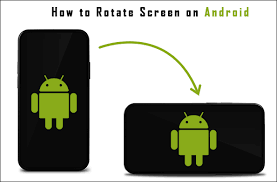Do you ever get tired of staring at your Android screen in the same old orientation? Well, it’s time to shake things up and enjoy a fresh perspective with easy methods to rotate your screen on Android.
Whether you want to switch from portrait to landscape mode or simply need a different angle, we’ve got you covered. In this article, we’ll show you how to use the built-in rotation settings, quick settings, screen rotation control apps, and even advanced developer options to customize your screen rotation experience.
And if you encounter any common rotation issues, don’t worry, we’ve got troubleshooting tips for that too.
So, get ready to discover the tricks and techniques that will give your Android device a whole new look and feel.
Let’s dive in and enjoy a screen rotation revolution on Android!
Key Takeaways
- There are multiple methods to rotate the screen on Android, including built-in rotation settings, quick settings, screen rotation control apps, and developer options.
- Troubleshooting rotation issues can involve checking the auto-rotate feature, restarting the device, uninstalling conflicting apps, updating software, and performing a factory reset as a last resort.
- Tips and tricks for screen rotation include enabling rotation in quick settings, restarting the device, uninstalling conflicting apps, and performing a factory reset as a last resort.
- These methods can help users enjoy a fresh perspective by easily switching between portrait and landscape modes on their Android devices.
Using the Built-in Rotation Settings
To rotate the screen on your Android device, simply swipe down from the top of your screen to access the quick settings panel. Then, tap on the rotation icon to switch between portrait and landscape modes effortlessly.
This built-in feature allows you to enjoy a fresh perspective on your device without any hassle. Whether you want to read an article in portrait mode or watch a video in landscape mode, it’s as easy as a tap of a button.
With the rotation settings, you have the flexibility to adapt the screen orientation to your needs at any given moment. So go ahead and explore the world of possibilities that come with rotating your screen on Android.
Using Quick Settings to Rotate Your Screen
Using the quick settings menu on your device, you can effortlessly switch the orientation of your phone’s display for a whole new viewing experience.
To access the quick settings menu, simply swipe down from the top of your screen to reveal the notification shade. You’ll see various icons representing different settings. Look for the one that looks like a square with arrows rotating inside it. Tap on this icon to enable screen rotation.
Once activated, you can rotate your device to your desired orientation, whether it’s portrait or landscape.
This quick and convenient method allows you to easily rotate your screen without diving into the settings menu. Enjoy a fresh perspective with just a few taps!
Using a Screen Rotation Control App
Get a whole new viewing experience with a screen rotation control app on your Android device. With this app, you can easily rotate your screen to any desired orientation with just a few taps.
Simply download and install a screen rotation control app from the Google Play Store, such as ‘Rotation Control.’ Once installed, open the app and you’ll find various options to customize your screen rotation settings. You can choose to enable or disable auto-rotation, set specific rotation angles, and even create custom rotation rules for specific apps.
This way, you can enjoy your favorite videos, games, and apps in landscape or portrait mode, whichever suits your preference. Say goodbye to the hassle of manually adjusting your screen orientation and embrace the convenience of a screen rotation control app on your Android device.
Using Developer Options for Advanced Rotation Settings
Discover a whole new level of control over your device’s screen rotation with the advanced settings in Developer Options. To access these settings, go to your device’s Settings menu and scroll down to ‘About phone’ or ‘About tablet.’ Tap on it, and then find the ‘Build number’ or ‘Software information’ option. Tap on it repeatedly until a message appears, indicating that you’ve enabled Developer Options.
Now, go back to the main Settings menu and scroll down to find the newly unlocked Developer Options. Tap on it, and then locate the ‘Force RTL layout direction’ or ‘Force screen rotation’ option. By toggling this option on or off, you can manually control the screen rotation settings on your device, allowing you to enjoy a fresh perspective whenever you want.
Troubleshooting Common Rotation Issues
Having trouble with screen rotation on your device? Let’s troubleshoot some common issues together.
First, make sure that the auto-rotate feature is enabled in your device settings. If it’s already enabled and still not working, try restarting your device. Sometimes a simple restart can fix minor glitches.
If the problem persists, check if any apps or games are causing conflicts with the screen rotation. Try uninstalling or disabling those apps to see if it solves the issue.
Additionally, check if your device has the latest software updates installed. Sometimes, outdated software can cause rotation problems.
Lastly, if none of these steps work, you can try performing a factory reset as a last resort. Remember to back up your data before doing so to avoid any data loss.
Tips and Tricks for Screen Rotation on Android
Having trouble with your screen rotation on your Android device? Don’t worry, we’ve got you covered with some handy tips and tricks!
Let’s dive right in and discover how you can enjoy a fresh perspective with easy methods.
Firstly, make sure that the screen rotation is enabled on your device. You can do this by swiping down from the top of your screen to access the quick settings panel, then tapping on the screen rotation icon.
If that doesn’t work, try restarting your device as sometimes a simple reboot can fix the issue.
Additionally, check if any third-party apps are causing conflicts with the screen rotation and consider uninstalling them.
Lastly, if all else fails, you can try performing a factory reset to restore your device to its default settings.
With these tips and tricks, you’ll be able to effortlessly rotate your screen and enjoy a fresh perspective on your Android device.
Frequently Asked Questions
Yes, you can rotate the screen on your Android device using a physical button or shortcut key. Just press the button or combination of keys, and your screen will rotate accordingly.
Yes, it is possible to rotate the screen on your Android device only for certain apps or games. Simply go to the app or game, rotate your device, and the screen will adjust accordingly.
Rotating the screen on your Android device won’t significantly affect battery life. However, if you use auto-rotate frequently, it may consume a small amount of battery power due to the sensors constantly detecting orientation changes.
To lock the screen rotation in a specific orientation on your Android device, go to the Settings menu, choose Display, and enable the “Auto-rotate screen” option. Then, simply rotate your device to the desired orientation and it will stay locked.
Yes, you can customize the rotation settings for individual apps on your Android device. Simply go to the app’s settings, find the display or rotation options, and adjust them according to your preference.
Conclusion
So now you know how to rotate the screen on your Android device with ease. Whether you prefer using the built-in rotation settings, quick settings, a screen rotation control app, or the developer options for advanced settings, there are plenty of options available to suit your needs.
And if you encounter any common rotation issues, you now have some troubleshooting tips to help you out.
So go ahead and enjoy a fresh perspective on your Android device with these simple methods. Happy screen rotating!


